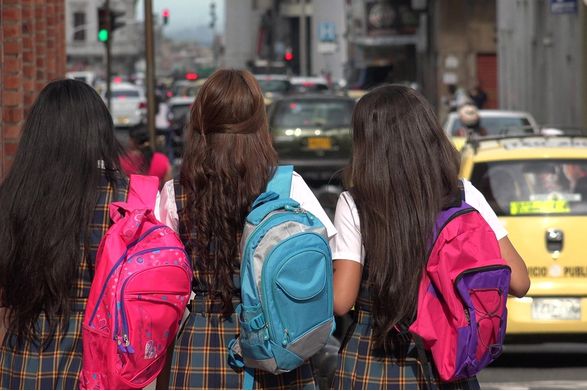If you wonder what the admissions process at New York’s specialized high schools might look like after Mayor Bill de Blasio gets through with it, look no further than Bruce Holsinger’s The Gifted School, this summer’s beach read for elites. Though the novel takes place in Denver’s northern suburbs, it could just as well occur in Brooklyn’s Park Slope. Its plot centers around Crystal Academy, a newly opened charter magnet school for high-achieving children. Though they feign indifference, four women pull out all the stops to gain admission for their kids, in the process tearing their friendships apart. “They’re hailing it as the Stuyvesant of the Rockies,” one character explains, for the “exceptionally gifted.” The word gifted, Holsinger writes, “slashed like a guillotine through other topics. Around the table the talk ceased.”
The new school offers just 1,000 slots for nearly 100,000 eligible children; each parent believes that his or her child is perfectly suited for admission. A cast of gifted students seeks enrollment: the math genius with an autism-spectrum disorder, the mean-girl daughter of the wealthy city councilor, the high-level soccer-playing twins, the book-loving daughter of the neuroscientist, the recovering drug-addict fashion designer, and—looking to gain entry into this meritocracy—the son of the cleaning lady.
Of course, an education at Crystal Academy isn’t limited to gifted children of the wealthy elite. It’s also an opportunity, the school proclaims, for minority children who live in nearby trailer parks. But they must make “the first cut”—the CogPro admissions test. In a ripped-from-the-headlines twist, foretelling the recent admissions scandal at U.C. Berkeley, a father pays experts to diagnose his daughter with ADHD so that she can get extra time on the exam.
Yet the test isn’t really a firm standard of admission. Score cutoffs vary by county. “They don’t test as well in the boondocks,” one character, a social worker, explains. “You have built-in testing biases, racial and economic disparities in educational attainment . . . We see it all the time at Youth and Family Services, plus social and psychological issues like nutrition and health care. Even nonverbal IQ scores are affected by environmental circumstances.” A local parent group opposes the school forms. And the newspaper editorializes that “we can all agree on . . . the need to safeguard against the inherent biases exhibited by standardized tests, such as the CogPro.” Critics want to know how the admissions process will “account for differences of race, ethnicity, economic privilege, national origin, linguistic proficiency, and ability.”
The novel makes no acknowledgement that plenty of poor kids test into New York’s real-life Stuyvesant High. Problem is, they’re usually not the right race to satisfy activists. Unlike Stuyvesant, Brooklyn Tech, and New York’s other elite high schools, which currently hold every child to the same academic standard, the fictional Crystal Academy uses its exam to eliminate about 80 percent of the eligible pool. Once they pass the test, students are then judged on their submitted portfolios. And this is where things go off the rails—because, well, no one knows what a portfolio is supposed to measure. Like college application essays, they are subject to manipulation.
“We’re assessing the whole child,” the principal explains. “Aptitudes and special talents. Perseverance and stick-to-it-iveness. Does she play a musical instrument with distinction? Does he have a unique approach to problem solving?” Crystal Academy’s future graduates will be Rhodes scholars and Supreme Court clerks, the principal explains. “I mean, you can see them giving TED Talks in ten years.”
On behalf of their children, parents submit portfolios that effectively parody those that future TED talkers might create. A girl with limited experience horseback riding includes an instructor’s letter saying that she is a “natural.” An 11-year-old audits a class on entrepreneurship at the local university—where her father contributes bundles of money—and puts together a portfolio on “leadership.” The recovering addict includes her fashion designs; the cleaning lady’s son possesses a talent for origami that convinces the school of his innate math abilities.
Racial politics also come into play. After the origami-making, trilingual cleaning lady’s son is asked to stand and be recognized at an event, the father of the soccer-playing twins “couldn’t help but feel a flash of indignant annoyance that the school system would put a student of color on display like that just to make a point to a bunch of white liberals—though the sudden surge of righteousness did little to quell his envy of the Peruvian kid’s multicultural fluency.” His own children were half Punjabi, but “as his ex would be the first to point out, being Pakistani or any kind of South Asian was hardly an edge, given today’s pretzel twisted notions of affirmative action.”
Though Holsinger occasionally skewers liberal conceits, he puts criticisms of the admissions scheme only in the mouths of a Neanderthalish father who has an affair with his au pair and an uber-wealthy fitness instructor who spoils her daughter. Still, for a segment of New Yorkers, reading The Gifted School will be something like looking into a mirror.


